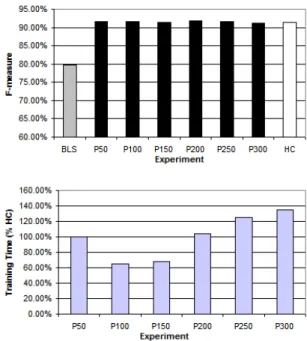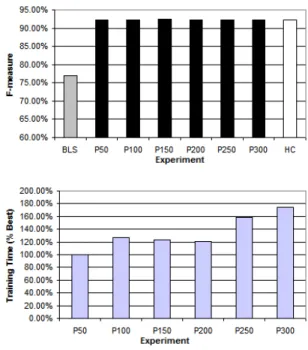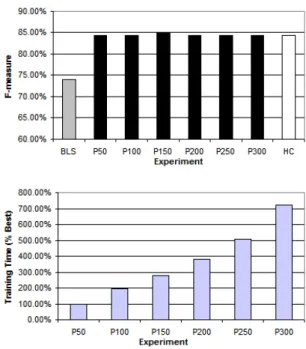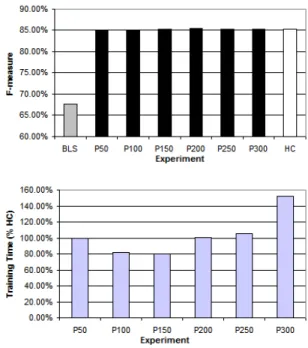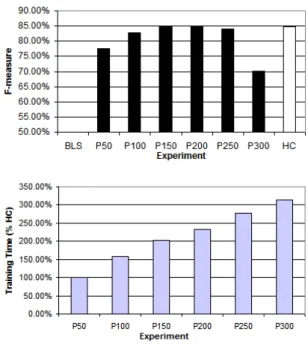Generation
Ruy Luiz Milidiú
1, Julio Cesar Duarte
1,2and Cícero Nogueira dos Santos
11
Departamento de Informática Pontifícia Universidade Católica Rua Marquês de São Vicente, 225, Gávea
Phone: +55 (21) 3527-1500
Zip 22453-900 - Rio de Janeiro - RJ - BRAZIL {milidiu | jduarte | nogueira }@inf.puc-rio.br
2
Centro Tecnológico do Exército Av. das Américas, 28705, Guaratiba
Phone: +55 (21) 2410-6200
Zip 23020-470 - Rio de Janeiro - RJ - BRAZIL jduarte@ctex.eb.br
Abstract
Transformation Based Learning (TBL) is a Machine Learning technique frequently used in some Natural Lan-guage Processing (NLP) tasks. TBL uses rule templates to identify error-correcting patterns. A critical requirement in TBL is the availability of a problem domain expert to build these rule templates. In this work, we propose an evolutionary approach based on Genetic Algorithms to automatically implement the template generation process. Additionally, we report our findings on five experiments with useful NLP tasks. We observe that our approach provides template sets with a mean loss of performance of0.5%when compared to human built templates
Keywords: Machine Learning, Genetic Algorithms, Transformation Error-Driven Based Learning.
1. I
NTRODUCTIONTransformation Based error-driven Learning (TBL) is a symbolic machine learning method introduced by Eric Brill [1]. The TBL technique builds an ordered set of rules that correct mistakes of a base line classifier. It has been used for several important linguistic tasks, such as part-of-speech (POS) tagging [1], parsing [8], preposi-tional phrase attachment [2] and phrase chunking [9, 6], achieving state-of-the-art performance in many of them.
Although TBL has been surpassed by other techniques for some advanced tasks, it is still competitive for sev-eral relevant NLP tasks, with the advantage of
produc-ing explicit rules that can be understand by humans. One possible reason for TBL’s modeling limitations in some advanced tasks is that not all problems can be solved by investigating a small, local window of features around a given token. In some problems, there are unbounded de-pendencies which do not fit into this small window and are hard for experts to determine.
Within the TBL framework, the generated rules must follow patterns called templates, which are meant to cap-ture the relevant feacap-ture combinations. The accuracy of the TBL classifier is highly dependent on the template set used in the learning process. Unfortunately, the process of generatinggoodtemplates is highly expensive and de-pends on the problem expert skills.
In [7], we address the problem of automatic TBL tem-plate generation based on Genetic Algorithms (GAs). We introduce four genetic approaches, each one with a differ-ent degree of understanding of the problem. The better the understanding, the better is the accuracy of the generated classifier.
In this work, we provide a detailed description of our evolutionary approach. Additionally, we include more empirical evidence to support our findings. Our experi-ments show that we can achieve the same quality as the best template set for some benchmark problems. The overall training time is also compatible since it is in-creased by a factor that is smaller than the human-driven template generation process.
Section 2 presents a brief overview of GAs and TBL. In Section 3, we describe our genetic approaches. Section 4 presents the five NLP problems used and also our ex-perimental findings. In the final section, we present our conclusions and some future work.
2. T
ECHNIQUES 2.1. GENETICALGORITHMSGenetic Algorithms (GAs) [5] are a family of compu-tational models inspired both by the Evolution and Nat-ural Selection processes. They model the solution of the problem into a data structure calledchromosome, or genotypeorgenome, which represents the possible solu-tions, calledindividuals, orcreaturesor phenotypes. A series of genetic operators are applied to these chromo-somes in order to achieve a high optimization of the prob-lem.
Two components play an important role in the GA method: the problem codification and the evaluation function. The problem codification is the mapping that is made between the chromosomes and the individuals. Usually, the individuals are mapped into a string of 1’s and 0’s indicating the presence, or not, of some feature or characteristic as shown in Figure 1. The evaluation func-tion takes one individual and calculates its fitness. Usu-ally, the fitness is a performance measure of the individual as a solution to the problem.
f0 f1 f2 f3 f4 f5 f6 f7 f8 f9
1 1 1 0 0 1 1 0 1 0
Figure 1. Chromosome Example
A genetic algorithm starts with a random population of individuals. The current population is changed by the genetic operators into a new generation of individuals. The main objective of a generation is to keep thebest in-dividuals, enhancing the overall fitness of the population, until some stopping criteria is achieved. This criteria can be a fitness threshold, the number of generations or the lack of improvement.
There are two kinds of genetic operators: selection and recombination. Selection operators use the evalua-tion funcevalua-tion to decide which individuals have the highest potential. These individuals may persist in the population and will be used by the other kind of operators.
The recombination operators are used to create new individuals using one or more high potential individuals. They are meant to diversify the search process. The most famous operators in this class are cross-over and muta-tion. The cross-over operator uses two or more fractions of high potential individuals to build a new individual
which is appended to the next generation of the popula-tion. The mutation operator, on other hand, takes one high potential individual and makes a slight change in one of its components. The new individual is also appended in the next generation of the population.
A pseudo-code for a genetic algorithm is given in Al-gorithm 1.
Algorithm 1A Genetic Algorithm Pseudo-Code 1: Choose an initial random population of individuals 2: Evaluate the fitness of the individuals
3: repeat
4: Select thebestindividuals to be used by the genetic operators
5: Generate new individuals using crossover and mu-tation
6: Evaluate the fitness of the new individuals 7: Replace theworstindividuals of the population by
the best new individuals 8: untilsome stop criteria
2.2. TRANSFORMATIONBASEDLEARNING
Transformation Based error-driven Learning (TBL) uses a greedy error correcting strategy. Its main objec-tive is to generate an ordered list of rules that correct clas-sification mistakes in the training set, which have been produced by a baseline system.
The baseline system is an algorithm that classifies the unlabeled training set by trying to guess the correct class for each sample. In general, the baseline system is based on simple statistics of the labeled training set.
The requirements of the TBL algorithm are: a train-ing corpus, a template set, a baseline system and a score threshold. The learning method is a mistake-driven greedy procedure that iteratively acquires a set of transfor-mation rules from the template set maximizing its score. The score from a rule can be defined as the number of corrections that it achieves in the training corpus in some iteration of the learning process, discounting the number of mistakes it makes in the same corpus. At each itera-tion, the rule with best score (better than the threshold) is chosen to be used in the generated classifier. The thresh-old value can be tuned to avoid overfitting to the training corpus. The classification process of a new sample can be done by simply applying the baseline systemBLS and the ordered rule setR. The pseudo-code of the TBL algo-rithm is shown in Algoalgo-rithm 2.
Algorithm 2The TBL Algorithm Pseudo-Code
input A training corpusC0, a template setT, a baseline systemBLSand an integer thresholdτ
1: ApplyBLS toC0generatingC1 2: R← {}
3: k←1 4: repeat
5: Generate CRk, instantiating all candidate rules
fromT usingCk,
6: for allr such thatr∈CRkdo
7: score(r)←#(good corrections of r) - #(bad cor-rections of r) inCk
8: end for
9: ChooserM fromCRk with highest positive score
aboveτ
10: ifrM existsthen
11: ApplyrM toCkgeneratingCk+1 12: R←R+rM.
13: end if
14: k←k+ 1 15: untilnotrM exists
output R
ofAtomic Terms (ATs). An AT is the smallest template unit that indicates the feature and conditions to be instan-tiated in a template. It is meant to identify one peace of the context that a TBL rule needs to test when applying to the target token. Some examples of ATs are:
1. f[ds], which checks the featuref of a token, located dstokens to the left or right (depending of the sign) of the target token. For example:f1[-1];
2. f[ds,de], which checks the featuref in an interval of tokens positioned betweendsandde(included), in relation to the target token. For example:f1[-1,1];
3. f[ds,de]_where(f’=v’), which checks the feature f of the token nearest to the target token, within the closed interval ofdsandde, for which the featuref ’ equalsv’[4]. For example:f1[-1,-5]_where(f2=v).
More complex atomic terms can be defined in order to create more specialized rules.
3. A
PPROACHESIn this section, we show the genetic coding used in our experiments. The use of genetic algorithms in con-junction with TBL has already been examined in [13], where they are used in the TBL training process to gener-ate the instantigener-ated rules and to provide an adaptive rank-ing. Nevertheless, they have not been used in the evalua-tion of template sets what is our proposal. In all codings,
the template ordering is not taken into account, since it is the last criteria to be used when two or more rules have the same score.
3.1. GENETICCODING
3.1.1. Fixed Context Window: In this approach, the chromosomeis composed by several sequences of possi-ble atomic terms (ATs) of the simplest formf[ds]. The value in thechromosomedetermines the presence or ab-sence of the corresponding AT in the template. The input for this coding is composed by the following items: the list of possible features to be used, an integer value max-Offset, the number of templates to be generated and an expected number of atomic terms in each template. The generated templates are sequences of atomic terms of the formf[ds], whereds∈ {-maxOffset, +maxOffset}. An example of this coding is given in Table 1, showing two templates with expected size 3, using 2 features,f1 and f2, and maxOffset equals to 1.
Thechromosomeshown in the Table 1 generates the following two templates:
1. f1[-1]f1[+1]f2[-1]f2[+1] 2. f2[-1]f2[0]
3.1.2. Fixed List of Atomic Terms: Usually, it is eas-ier to identify candidate atomic terms by looking at the output errors of a Machine Learning Algorithm. In Fixed List of Atomic Terms, thechromosomeis very similar to the previous one, but it can be composed by sequences of a given set of atomic terms. Thechromosome value also indicates the presence or the absence of the corre-sponding atomic term in the template. The input for this coding is the list of possible atomic terms to be used, and, as well, the number of templates to be generated and the expected number of atomic terms. An exam-ple of this coding is given in Table 2, showing two tem-plates with expected size 3, using 6 different possible atomic terms f1[−1], f1[−2], f2[0], f2[1], f1[0,2] and f2[−2,−0]_where{f1=v1}.
Thechromosomeshown in the Table 2 generates the following two templates:
1. f1[−2]f2[0]f2[−2,−0]_where{f1=v1} 2. f1[−1]f2[0]f1[0,2]
Template 1 Template 2
f1[-1] f1[0] f1[+1] f2[-1] f2[0] f2[+1] f1[-1] f1[0] f1[+1] f2[-1] f2[0] f2[+1]
C1 1 0 1 1 0 1 0 0 0 1 1 0
Table 1. Example of the Fixed Context Window Approach
Template 1 Template 2
AT0 AT1 AT2 AT3 AT4 AT5 AT0 AT1 AT2 AT3 AT4 AT5
C1 0 1 1 0 0 1 1 0 1 0 1 0
Table 2. Example of the Fixed List of Atomic Terms Approach
this coding is the list of possible atomic terms to be used, the number of templates to be generated and the maxi-mum template size. An example of this coding is given in Table 3, showing three templates with maximum size 4, using the same six possible previous atomic terms.
Thechromosomeshown in the Table 3 generates the following three templates:
1. f1[−1]f1[−2]f2[1]
2. f1[−2]f2[0]f2[1]f2[−2,−0]_where{f1=v1}
3. f1[−2]f2[0]f2[1]
3.1.4. Template List: In this approach, the chromo-someis composed of a sequence of predefined templates. The idea here is to find a better subset of templates than the one provided by an expert. Since TBL is a greedy algorithm, using all templates may not lead to better re-sults than using just one of its subsets. Thechromosome value indicates the presence or absence of the correspond-ing template. The input for this codcorrespond-ing is the list of pos-sible templates to be used and the expected number of templates to be used. An example of this coding is given in Table 4, showing templates from the fixed template list,
{τ00,τ01,τ02,τ03,τ04,τ05,τ06,τ07,τ08,τ09,τ10,τ11}, with an expected number of seven templates.
Thechromosomeshown in the Table 4 generates the following template set:{τ00,τ02,τ05,τ06,τ08,τ09,τ10}.
3.2. FITNESS FUNCTION
Using a training set, we train a TBL classifier for each individual. The F-measure of the generated classifier for a validation set is used as the fitness value of the individual.
3.3. CROSS-OVER OPERATOR
The cross-over operator generates a newchromosome by breaking apart two chromosomes in a random point and combining them. Table 5 shows an example of the cross-over operator for thechromosomedescribed in the Fixed Context Window approach.
3.4. MUTATION OPERATOR
The mutation operator generates a new chromosome by changing the value of the atomic term in a template. Table 6 shows an example of the mutation process for the chromosomedescribed in the Fixed Context Window ap-proach.
For the Maximum Template Size approach, instead of changing the value from0to1and vice-versa, the value is changed to another value in the interval[-1, number of atomic terms - 1].
4. E
XPERIMENTS 4.1. NLP PROBLEMSWe conduct five experiments with useful NLP tasks: English Base Noun Phrase Chunking (BNP), English Text Chunking (CK), Portuguese Named Entities Recogni-tion(NE), Portuguese Noun Phrase Chunking (SN) and Portuguese Appositive Extraction (AP). This experiments are meant to illustrate the quality of our genetic ap-proaches.
Noun Phrase Chunking consists in recognizing non-overlapping text segments that correspond to noun phrases (NPs). Text chunkingconsists in dividing a text into syntactically correlated parts of words. Named En-tity Recognitionis the problem of finding all proper nouns in a text and to classify them among several given cate-gories such as Person, Organization or Location. Finally, Appositive Extractionconsists in recognizing structures composed by semantically related noun phrases that must be identical in reference, that is, they are co-referential.
Template 1 Template 2 Template 3 AT1 AT2 AT3 AT4 AT1 AT2 AT3 AT4 AT1 AT2 AT3 AT4
C1 1 3 -1 0 5 1 3 2 1 2 1 3
Table 3. Example of the Maximum Template Size Approach
τ00 τ01 τ02 τ03 τ04 τ05 τ06 τ07 τ08 τ09 τ10 τ11
C1 1 0 1 0 0 1 1 0 1 1 1 0
Table 4. Example of the Template List Approach
The Named Entities corpus used is the same reported in [10] which contains POS and NE tags. In the Portuguese Noun Phrase experiments, we use the corpus reported in [12]. This corpus has both POS and SN tags. The last conducted experiment is Portuguese Appositive Extration (AP) and uses the corpus reported in [3]. This corpus is derived from the SN corpus containing the AP tags.
4.2. EXPERIMENTALSETUP
In all experiments, a small excerpt of the training cor-pus is used by the genetic approach. Two corpora are built: a training set and a validation set. The GA-training and validation sets are used by the genetic algo-rithm to, respectively, train and evaluate the performance of the individuals. The best individual returned by the genetic algorithm is applied to the whole training corpus, generating a TBL classifier. The classifier is, then, applied to the test corpus and its performance is evaluated.
We use F-measure as our key statistics to evaluate the performance of the generated classifiers. F-measureis the harmonic mean between precision and recall. Pre-cisioninforms how many good classifications the model predicted amongst all predictions made. Recallinforms how many good classifications were predicted amongst all true classifications.
For the four genetic formulations, we report the per-formance of the classifier trained with thebest template set produced by the use of different slices of the GA-training set in the genetic approach. These results are compared with the Baseline System (BLS) and a hand-crafted template set (HC) obtained from the referenced articles. We start with50sentences for the genetic train-ing process, increastrain-ing with 50more examples in each experiment.
Although, we fixed theτparameter used in all exper-iments to the same value used by the handcrafted tem-plates, it could also be encoded and determined by the ge-netic algorithm without considerable loss of performance, since its set of optimal values is very limited (usually,
0≤τ ≤2).
We also report the training time for each approach,
in terms of percentage of the training time for the ex-periment with50sentences. The reported training time includes both the generation of the best template set by the genetic algorithm and the training of the TBL classi-fier. The BLS training time is not reported since it is very small.
In all approaches, the performance of the population in the validation set over the ten fixed generations shows a consistent increase.
4.3. RESULTS
4.3.1. English Base Noun Phrase Chunking: The results for the Fixed Context Window (FCW) approach are reported in Figure 2. The experiment is conducted us-ing the three possible features (word, POS and NP tag) with a window size of five ([-2, +2]). The genetic al-gorithm generated 20 templates with an expected atomic term size of 3. As we can see, the results are very good since we generate only 20 templates with the simplest atomic term. The loss of F-measure is smaller than1%
in the best ga-training sets. Also the genetic approaches takes few training time, since the templates are very sim-ple. It is interesting to notice here that the training time decreases in the first increases of the genetic training cor-pus. This fact occurs because the BLS depends on the provided training corpus and, since the training corpus is very small, its accuracy is very poor, providing many errors for the genetic TBL templates to correct, which in-creases the overall training time.
Template 1 Template 2
f1[-1] f1[0] f1[+1] f2[-1] f2[0] f2[+1] f1[-1] f1[0] f1[+1] f2[-1] f2[0] f2[+1]
C1 1 0 1 1 0 1 0 0 0 1 1 0
C2 1 1 0 0 0 1 1 1 0 1 0 0
C1⊗C2 1 0 1 1 0 1 0 1 0 1 0 0
Table 5. Example of the Cross-over operator
Template 1 Template 2
f1[-1] f1[0] f1[+1] f2[-1] f2[0] f2[+1] f1[-1] f1[0] f1[+1] f2[-1] f2[0] f2[+1]
C1 1 0 1 1 0 1 0 0 0 1 1 0
¯C1 1 0 1 1 0 1 0 0 0 0 1 0
Table 6. Example of the Mutation operator
Figure 2. Results for the Fixed Context Window approach (BNP)
rules.
The experiment using the Fixed List of Atomic Terms (FLAT) approach is quite similar to the previous one, with same main parameters, and is reported in Figure 4. The only difference is that we define the expected tem-plate size, which was fixed in 4. We can see that the re-sults are very similar to the previous one, in terms of F-measure and training time, since the two approaches are quite equivalent.
The last experiment for BNP uses the Template List (TL) approach. In this experiment, we try to find out a better combination of templates than the one provided by a specialist. Here, we use the template set proposed in [9].
Figure 3. Results for the Maximum Template Size approach (BNP)
The genetic generations are started with80%of the tem-plates activated. Figure 5 shows the results for this exper-iment. We can see that the template combination found by our approach achieve better results than the template set proposed by the specialist. However, this achievement implies in an increase of the overall training time.
4.3.2. English Text Chunking: In all following ex-periments, we use the same parameter setting as the one for BNP. This shows the power and simplicity of our scheme.
Train Data Test Data NLP Problem
Sentences Tokens Sentences Tokens English Base Noun Phrase
8936 211727 2012 47377 English Text Chunking
Portuguese Named Entities Recognition 1722 27055 378 6084
Portuguese Noun Phrase Chunking 10051 210044 2206 46847
Portuguese Appositive Extraction 3681 79560 807 17942
Table 7. NLP Tasks Corpora.
Figure 4. Results for the Fixed List of Atomic Terms approach (BNP)
ones, even with the simplest approach.
4.3.3. Portuguese Named Entity Recognition: We show the results of the genetic approaches for NE in Fig-ures 10, 11, 12 and 13. Here, the results with FLAT and TL are even better than the ones provided by the hand-crafted templates. The only difference is that the automat-ically generated templates took much more time to train since they are much more generic than the handcrafted templates.
4.3.4. Portuguese Noun Phrase Chunking: We compare the results with the handcrafted templates described in [12]. We must observe that this template set contains very sharp domain knowledge. This certainly
Figure 5. Results for the Template List approach (BNP)
required a lot of engineering effort to be acquired. Figures 14, 15, 16 and 17 report the results for all genetic approaches. The results with MTS are very close to the reference values. The template set reduction by the TL approach does not improve performance. This indicates that all the handcrafted templates are critical to the model performance.
4.3.5. Portuguese Appositive Extraction: Figures 18, 19, 20 and 21 show these results in all described ap-proaches.
Here, the BLS in not an AP extractor. Its function is just to provide hints that help TBL learning. Therefore, it does not have a performance to evaluate and compare.
Figure 6. Results for the Fixed Context Window approach (CK)
Figure 7. Results for the Maximum Template Size approach (CK)
shows a good performance, close by 1% to the hand-crafted templates.
Figure 8. Results for the Fixed List of Atomic Terms approach (CK)
Figure 9. Results for the Template List approach (CK)
4.4. EXPERIMENTALFINDINGS
Figure 10. Results for the Fixed Context Window approach (NE)
Figure 11. Results for the Maximum Template Size approach (NE)
a very expensive task and requires TBL engine expertise. The training time in all cases increased from a few minutes, with the handcrafted templates, to a few hours, when we include the evolutionary template generation. Observe, however, that handcrafting the templates re-quires a series of trial-and-error TBL modeling and
train-Figure 12. Results for the Fixed List of Atomic Terms approach (NE)
Figure 13. Results for the Template List approach (NE)
Figure 14. Results for the Fixed Context Window approach (SN)
Figure 15. Results for the Maximum Template Size approach (SN)
5. C
ONCLUSIONSTBL Template construction is a highly expensive pro-cess with strong impact in the classifier’s accuracy. In this paper, we present an evolutionary approach to help the generation of TBL templates. Our schemes use
sim-Figure 16. Results for the Fixed List of Atomic Terms approach (SN)
Figure 17. Results for the Template List approach (SN)
ple template design and very little training data to develop a set of templates.
Figure 18. Results for the Fixed Context Window approach (AP)
Figure 19. Results for the Maximum Template Size approach (AP)
when comparing to the ones obtained by handcrafted tem-plates. In some cases, the results provide even a better F-score. Moreover, the overall training time is reduced since the domain expert is removed from the template genera-tion process.
In the future work, we plan to analyze the fitness
func-Figure 20. Results for the Fixed List of Atomic Terms approach (AP)
Figure 21. Results for the Template List approach (AP)
R
EFERENCES[1] Eric Brill. Transformation-based error-driven learn-ing and natural language processlearn-ing: A case study in part-of-speech tagging. Computational Linguistics, 21(4):543–565, 1995.
[2] Eric Brill and Philip Resnik. A rule-based approach to prepositional phrase attachment disambiguation. InProceedings of COLING’94, Kyoto, Japan, 1994.
[3] Maria Claudia de Freitas, Julio Cesar Duarte, Cícero Nogueira dos Santos, Ruy Luiz Milidiú, Raúl P. Rentería, and Violeta Quental. A machine learning approach to the identification of apposi-tives. In Jaime Simão Sichman, Helder Coelho, and Solange Oliveira Rezende, editors, IBERAMIA-SBIA, volume 4140 ofLecture Notes in Computer Science, pages 309–318. Springer, 2006.
[4] Cícero Nogueira dos Santos and Claudia Oliveira. Constrained atomic term: Widening the reach of rule templates in transformation based learning. In Carlos Bento, Amílcar Cardoso, and Gaël Dias, ed-itors,EPIA, volume 3808 ofLecture Notes in Com-puter Science, pages 622–633. Springer, 2005.
[5] John H. Holland. Adaptation in Natural and Arti-ficial Systems. University of Michigan Press, Ann Arbor, 1975.
[6] Beáta Megyesi. Shallow parsing with pos taggers and linguistic features. Journal of Machine Learn-ing Research, 2:639–668, 2002.
[7] Ruy Luiz Milidiú, Julio C. Duarte, and Cícero Nogueira dos Santos. Tbl template se-lection: An evolutionary approach. In Daniel Borrajo, Luis A. Castillo, and Juan M. Corchado, editors, CAEPIA, volume 4788 ofLecture Notes in Computer Science, pages 180–189. Springer, 2007.
[8] Miloslav Nepil. Learning to parse from a treebank: Combining tbl and ilp. In Céline Rouveirol and Michèle Sebag, editors, ILP, volume 2157 of Lec-ture Notes in Computer Science, pages 179–192. Springer, 2001.
[9] Lance Ramshaw and Mitch Marcus. Text chunk-ing uschunk-ing transformation-based learnchunk-ing. In David Yarovsky and Kenneth Church, editors, Proceed-ings of the Third Workshop on Very Large Corpora, pages 82–94, New Jersey, 1995. Association for Computational Linguistics.
[10] Roberto Cavalcante Ruy Luiz Milidiú, Julio Cesar Duarte. Machine learning algorithms for portuguese named entity recognition. In
Solange Oliveira Rezende and Antonio Car-los Roque da Silva Filho, editors, Fourth Work-shop in Information and Human Language Tech-nology (TIL’06) in the Proceedings of Interna-tional Joint Conference, 10th Ibero-American tificial Intelligence Conference, 18th Brazilian Ar-tificial Intelligence Symposium, 9th Brazilian Neu-ral Networks Symposium, IBERAMIA-SBIA-SBRN, Ribeirão Preto, Brazil, October 23-28, 2006, 2006.
[11] Erik F. Tjong Kim Sang and Sabine Buchholz. Intro-duction to the conll-2000 shared task: chunking. In Proceedings of the 2nd workshop on Learning lan-guage in logic and the 4th conference on Computa-tional Natural Language Learning, pages 127–132. Association for Computational Linguistics, 2000.
[12] Cícero Nogueira Santos. Aprendizado de máquina na identificação de sintagmas nominais: o caso do português brasileiro. Master’s thesis, IME, Rio de Janeiro - RJ, fevereiro 2005.

